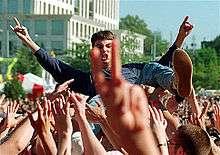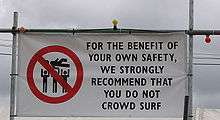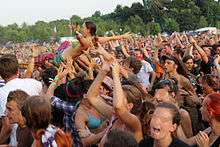Crowd surfing
Crowd surfing, also known as body surfing, is the process in which a person is passed overhead from person to person (often during a concert), transferring the person from one part of the venue to another. The "crowd surfer" is passed above everyone's heads, with everyone's hands supporting the person's weight. At most concerts and festivals the crowd surfer will be passed towards a barrier in front of the stage by the crowd, where they will be pulled off and put on their feet by the security stewards. Then, they will be sent back to the side or rear of the crowd at the end of the barrier or they may be ejected from the venue (depending on the policy enforced).
Crowd surfing generally occurs only towards the front of an audience where the crowd is dense enough to support a person's body. It is most popular at metal, punk, rock, rave and indie concerts.
In order to get above everyone's heads, a person can be given a boost, in which one person picks up another to launch them over the people's heads, or they can stage dive.
This has been known to happen to unwilling participants who have been boosted up by others by surprise, in which case, those participants may also be ejected.
Origins

Iggy Pop may have invented crowd surfing during the Cincinnati Summer Pop Festival (Midsummer Rock Festival) of 1970.[1] Joe "King" Carrasco appears in the first documented video of crowd surfing in the 1981 Rock Video "Party Weekend". Fans have reported that Peter Gabriel crowd surfed at concerts as early as 1982 during performances of "Lay Your Hands on Me". The rear sleeve of the live album Peter Gabriel Plays Live[2], originally released on vinyl in 1983, features a photograph of him crowd surfing, although the image has been rotated through 90 degrees so Gabriel appears to be standing. The first official video release that depicts Gabriel crowd surfing was POV, a live concert video released in 1990 and produced by Martin Scorsese.[3] When Billy Joel crowdsurfed in a concert during his 1987 concert tour of the Soviet Union, bandmate Kevin Dukes described it as the "Peter Gabriel flop".[4]
Dangers



Crowd surfing is illegal in some countries and patrons can, in theory, be ejected from the venue for partaking in the act. This is usually written in the fine print of the concert or festival ticket.
Supporters of crowd surfing say that by standing in the mosh pit, concert-goers should expect such behavior as part of a rock show and by standing more towards the side or rear of the venue they can easily avoid such behavior. They also say that serious injuries caused by crowd surfing are extremely rare. It is true that the majority of injuries caused by crowd surfing are only mild bruising, which occurs in any mosh pit without crowd surfing. Supporters will also argue that most crowd surfers are considerate and will wear soft shoes such as trainers, and refrain from wearing jackets in order to minimize injuries, and that it is common mosh pit etiquette to pick up anyone who has fallen over.
At larger events, such as festivals, crowd surfing can be used as a means of transporting individuals out of the crowd. On occasion, individuals may wish to leave the event because of any given reason, but there can be too many people bringing other people in. Therefore, some people use crowd surfing as a means to get out. Crowdsurfing can be used to help injured or sick participants find medical help quickly. A person losing consciousness at a large hot outdoor summer festival can arrive at medical help in less than a minute by being passed to security. Those facing the stage are often unaware of crowd surfers heading towards it and it is not uncommon for audience members to be kicked or otherwise hit in the back of the head. Opponents of crowd surfing reject these claims, claiming that it is inappropriate for crowd surfers, stagedivers and moshers to dominate the most attractive area of the audience (directly in front of the stage) with the threat of (accidental) violence forcing people who do not want to get injured to stand at the back or to the side, which are much less attractive locations. Opponents argue that all visitors pay the same price for admission and are entitled to experience the concert without risking to get kicked in the face or crushed by crowd surfers.
Crowd surfers also risk having personal items such as wallets or mobile phones stolen, or their shoes or clothes removed and thrown into inconvenient locations. This is known as "mosh-lobbing", usually done by audience members or even performers who see crowd surfing as a pointless activity.
In December 2004 when the Beastie Boys performed at the Manchester Arena in Manchester, England, Ad Rock stopped partway through a song to warn the crowds to stop surfing as somebody had been injured, following up the discouragement with "that shit is so old" and telling them to "save that shit for the MTV music awards".
Crowd surfing events
The world record holder for the highest number of crowd surfers (recorded) in one performance is a mixed genre band Enter Shikari during their performance at Reading festival in 2009. Enter Shikari provided the music and encouragement for this whilst security safely caught and redirected them out of a side gate back into the crowd.[5] For a world record, the crowd surfer MUST "surf" over the barrier to be classed as a valid entry.
Crowd surfing extended for the first time to the classical music scene, when in June 2014 at the Bristol Proms an audience-member was ejected by fellow audience members during a performance of Handel's Messiah after he took the director's invitation to "clap and whoop" to the music a step too far by attempting to crowd-surf.[6]
See also
References
- ↑ Richard Metzger (2010-09-22). "RAW POWER: IGGY POP INVENTS STAGE DIVING IN 1970 AND SMEARS HIMSELF IN PEANUT BUTTER". dangerousminds.net. Retrieved 2013-10-10.
- ↑ "Plays Live - Peter Gabriel | Songs, Reviews, Credits | AllMusic". AllMusic. Retrieved 2017-07-10.
- ↑ Bill Clarke (2008-09-07). "Bill Clarke: First Recorded Instance Of Crowd Surfing?". Bilclarke.blogspot.com. Retrieved 2013-10-08.
- ↑ Billy Joel: A Matter of Trust - The Bridge to Russia. Showtime. 2014-01-31.
- ↑ Enter Shikari (2009-08-31), ENTER SHIKARI - READING CROWDSURF MAYHEM, retrieved 2017-02-27
- ↑ "Audience ejects crowd-surfer from classical concert". Telegraph.co.uk. Retrieved 2017-02-27.
External links
| Wikimedia Commons has media related to Crowd surfing. |
- The earliest known instance of crowd surfing: Peter Gabriel performing Lay Your Hands On Me
- Crowd surfing at a rock festival in Poland (promotional video of Przystanek Woodstock)
- Leo Laporte crowd surfs at the DiggNation event at South by South West 2010
